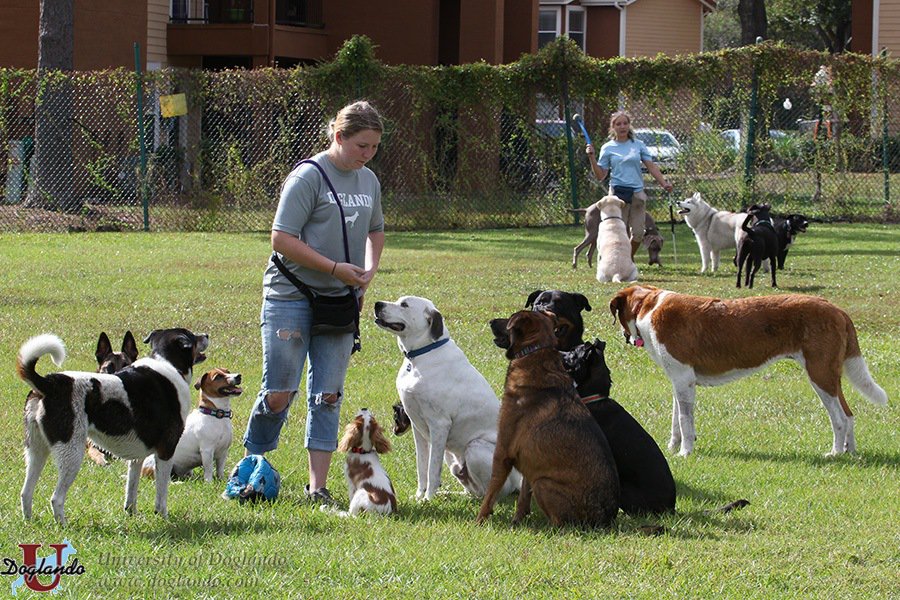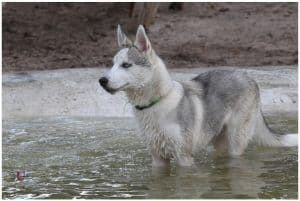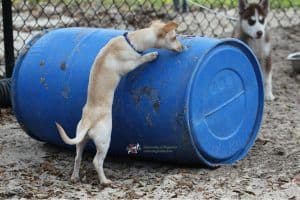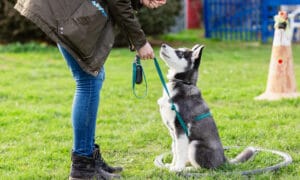“This post contains affiliate links, and I will be compensated if you make a purchase after clicking on my links.”

by Teena Patel, LLA CPDT
What New Puppy Parents Need to Know About Doggy Day Care
As the holidays approach, thousands of American families are considering adopting a puppy. It’s an exciting time, and parents are eagerly awaiting their children’s squeals of delight when they first see the wriggly balls of canine cuteness and energy. But soon, the kids are back in school and parents are back at work, and the new puppies are left on their own at home, where they become bored, lonely, and perhaps destructive.
Dog day care facilities offer to fill that gap, and they’ve become incredibly popular. They promise socialization and exercise during the day, and tired, happy puppies at home during the evenings. Inspired by these assurances, U.S. dog owners spent 2.5 billion dollars in 2015 on day care and boarding services for their pets, representing an almost 400% increase in the past 20 years.
Are dog day cares good for my new puppy?
Without realizing it, however, both puppy owners and dog day care providers often do far more harm than good. Confined within small spaces fitted with artificial surfaces and crammed with hard plastic play equipment, puppies experience social and physical frustration rather than play, proper socialization, and healthy movement.
Perhaps even more damaging, the environment of the dog day care facilities unknowingly stunts the development of puppies’ emotional maturity. This sensitivity plays a crucial role in a puppy’s ability to grow up as a confident, resilient, robust, socially adept, and cooperative dog that can live in a spirit of mutual respect with its human family.
Before you decide to send your new puppy to a care facility, there are some important factors you should keep in mind both about your pet, and the center that you trust to care for him. Most importantly, you need to consider whether this facility can provide an environment that teaches your dog lessons that are both appropriate and healthy for a puppy at his stage of emotional and physical maturity.
Why would my puppy have a tough time in doggy day care?
First, most puppies are forcibly weaned, and then separated from their mothers and litter mates so that they can be sold at 8-weeks of age. Thus, they lose very important elements of socialization and emotional development that they would have acquired naturally, if left undisturbed, through interactions with their mothers and fellow puppies.
For example, puppies that wean naturally are still suckling as their teeth grow in. When they suckle too hard or bite their mothers use a range of physical responses to teach the puppies that this behavior isn’t acceptable.
In short, the mothers teach the puppies how to use their mouths “politely”. Puppies learn how to be mindful of others, and as a result they can relate much more effectively to both other dogs and people. When this developmental milestone is achieved, training becomes so much easier, and puppies can learn how to live as part of a human household.
The importance of environment in dog daycare
When puppies don’t have the opportunity to gain these developmentally appropriate skills (because of early separation from their mothers), their new owners are faced with an important obligation: They must provide an environment, meaning everything that surrounds the puppy, that places them on the path to success.
As you consider day care centers for your puppy, there are many questions you should ask to determine whether this facility will provide an environment that promotes:
– Proper emotional development
– Healthy interactions with other dogs
– The opportunity to learn the skills that the puppy will need for life in the human world
Should puppies be placed with older, larger dogs in day care?

First, access the facility’s policy for housing puppies with other dogs. In most day cares, puppies are placed either with other puppies alone or with a mixture of puppies and small dogs. The theory is that placing puppies with larger and older dogs will put them in danger.
However, separating puppies like this has a highly negative effect on their overall development. When puppies are placed together without supervision they rampage and then crash. They do not learn positive skills, and instead have their negative behaviors such as nipping, barking, and aggression reinforced.
The situation is even worse when puppies are placed with older small dogs that do not have the physical size to brush off the excessive and unwanted attention from the frisky pups. The older dogs often resort to more aggressive responses, including biting, to drive away puppies that have not learned politeness. What puppies need is interaction with dogs of different ages and sizes to teach them lessons about sociability and politeness… behaviors that puppies would have learned from their mothers if allowed to wean naturally.
But, on its own, mixing in puppies with older dogs of different ages and sizes is not a sufficient environmental stimulus to help puppies develop in positive ways. The second question that should be asked of any dog care facility is, “How much, and what kind, of open space is available to my puppy?”
There’s no way around it – dogs need space to be dogs
Dogs need space. By nature, dogs do not like picking fights, or engaging in highly stressful or aroused environments. They would rather move away than continue in a confrontation.
However, when they are not given the opportunity to escape, it is normal under confined and highly stressful conditions for most dogs (some breeds more than others) to seek to control their environment, even if this includes engaging in very aggressive behavior. In fact, this is a major reason why most dog day cares will not put puppies with older dogs.
As a rule of thumb, a facility should have sufficient open, outdoor space to permit each dog to run at full speed and come comfortably to a full stop without encountering physical obstacles or colliding with other dogs. At The University of Doglando, we have four full acres of space that is all available to the dogs at all times. With no more than 60 dogs staying with us at any one time, they have complete freedom of choice about whether to interact with other dogs, or to go lie down alone. The result is a far less stressful environment where we have not had a single fight between dogs, including puppies, since we opened ten years ago.
A very important consequence of this open environment for puppies is that they learn that other dogs have a choice whether to interact with them, or simply to walk away. Puppies quickly understand that, to have the interactions they want, they need to behave politely and be mindful of the other dog. This is a crucial milestone that prepares puppies for the training they need to integrate themselves effectively into the life of a human family.
Is your puppy learning anything in doggy day care?
A third crucial question that puppy owners should ask is what lessons their puppies are learning during the day.
Most dog day care facilities, as the name implies, generally do not provide training. They focus solely on the care of the animals by ensuring that they are fed, get bathroom breaks, and have some degree of exercise. The staff in these facilities do not take the opportunity to engage deliberately with the dogs to facilitate their acquisition of new skills. As a result, your puppy won’t learn how to interact harmoniously with other dogs, with the staff of the day care, and with you, its owner.
In fact, rather than teaching new skills, the staff at dog care facilities inadvertently teach lessons, mostly through invasive and intrusive actions. As a result, the dogs often learn undesirable behaviors.
For example, dog day care facilities frequently squirt dogs with a hose or shake a noisemaker to get them to stop barking. In this scenario, dogs, including puppies, are taught to give up any responsibility for self-control. They learn that they will only stop behaviors when compelled to do so by a human. In other cases, dog care centers train their staff to use their own bodies to control movement and block dogs. These physical interventions often lead to staff being bitten or injured. That’s because, through experience, dogs learn that they can use their body and strength against humans.
Our dogs are always learning

These negative lessons are the natural consequence of a failure to understand how dogs learn. Thankfully, a properly designed environment, including a well-trained staff, can promote the types of learning that will prepare puppies to live with their families.
In contrast with the traditional model, when a puppy is introduced at the University of Doglando, careful and calculated measures are taken to ensure that he is engaged in environments that are designed to specifically elicit the behaviors we want to encourage. These behaviors include sitting at doorways, off leash recalls across the four acres of our facility, swimming, and sitting still for grooming.
At Doglando, the puppy has all the space he needs to explore, build confidence, and interact with other dogs. Just as importantly, the staff is trained in when to allow dogs to interact with each other, and when to become engaged by eliciting, and then reinforcing, a desired behavior. With this system, basic physical needs are met, but new puppies and adult dogs alike are also engaged in positive learning, both passively and actively, throughout the day.
Teena Patel, LLA CPDT, has a bachelor of science degree in comparative psychology and an MBA.
Teena is founder of the Country Day School at the University of Doglando, a 4 acre educational and enrichment center in Orlando. Teena is inspired by the idea that responsible pet-ownership requires a focus on the whole dog and teaching life skills rather than amusing tricks. She has developed new training methods to teach people how to interact positively with their animals starting most critically when they are puppies, and to integrate them fully into their lives. She brought this new model to Doglando, where a staff of professional trainers engage with their canine students of all ages throughout the school day to encourage positive behavioral outcomes. Patel has earned a national reputation for her innovative approach to training and dog care, and routinely consults around the country on her philosophy of enrichment, education, and improving dogs’ behavioral health.
























What I really love about choosing doggy daycare is for clients to get a tour of the options and see how well-kept the facilities are. Mom would surely be at peace leaving Blacky and Browny to a doggy daycare that is not only clean and safe, but also attractively designed and near our place. The dogs would definitely enjoy their temporary stay if they feel at home there with other dogs to play with.
I liked the tip that you gave to choose a daycare for your dog that will allow them to learn. My wife and I have been talking about getting a dog, and we would need to find a daycare for when we are both at work, and it would be important for us to know that we could find one that will be good for her. When we get a dog, I will be sure to look for a daycare with learning opportunities.
Barbara Leshin
says:This article is ridiculous. My rescue dog who had no socialization skills and didn’t even know how to play with a toy goes to daycare when work around the house will be noisy enough to scare him. He has learned to play with other dogs and is so happy to go to daycare. He wags his whole rear end when we arrive at this wonderful daycare facility and is so happy and tired at the end of the day. This article forgets that working pet parents now have an alternative to leaving lonely pets alone five days week. At daycare they are happy and busy and so well cared for.
I manage a 6,000+ sq ft cage free outdoor daycare in Southern California. Even though you bring up some valid points for puppies at a daycare you could have also mentioned that puppy owners need to also engage their puppies with all the proper and needed daily training at home as well. Since the “norm” is to take puppies away from their mothers and siblings too early, the pup is already at a disadvantage and the owner needs to address that issue right away.
We encourage all parents of puppies to get their pup into a training class that will best suit their puppies needs for their physical and mental growth. Doggie daycare is not the end all to “deal” with new puppy issues – unfortunately some puppy parents tend to depend on day cares to “fix” their puppies’ issues as they don’t have time to themselves. A good reminder for puppy/dog owners is to make sure that they have lots of time for their puppy first and that day care can provide a positive experience along side their interactions.